Brugmansia: description, types and varieties, features of planting and reproduction
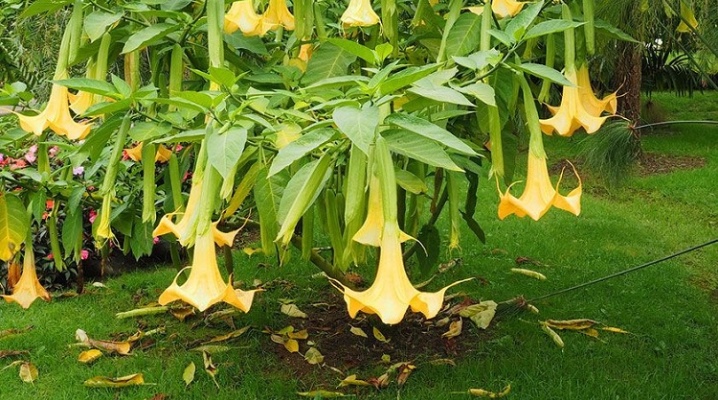
Brugmansia is extremely picturesque and stands out among other horticultural crops for its impressive appearance. Its large flowers are tubular-bell-shaped and resemble gramophones in appearance, the leaves are also quite large, bright green in color. In the recent past, the shrub was reckoned to the genus Durman (Datura), but then it was identified as an independent genus Brugmansiya. For the peculiar shape of the buds, the plant is also called "angel pipes".
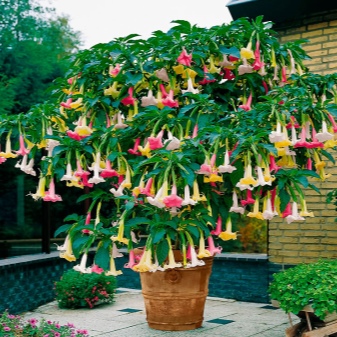
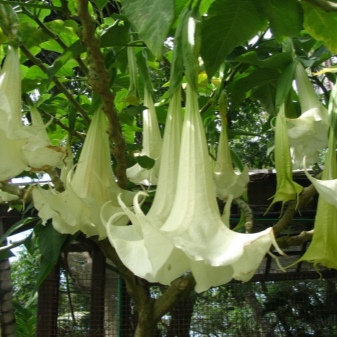
Description
Brugmansiya belongs to to the Solanaceae family, grows in the form of both a flowering perennial shrub and a low tree. In its natural environment, the plant can be found in South America. The crown of the shrub is well branched, with flexible, curly green stems. On them are slightly oblong oval-shaped leaf plates, painted in dark green. In some varieties, the leaves are serrated or pubescent with short hairs.
The length of the leaf plates on average can reach 30 cm. Brugmansia also has variegated forms. During the flowering period - in summer - tubular flowers form at the tips of the stems, more often they grow singly.
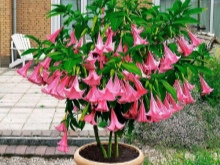
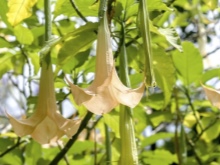
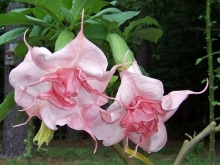
The buds have different colors, depending on the variety, their length varies from 25 to 50 cm, and the diameter can be 15–25 cm, they are always directed downward. Thanks to the efforts of breeders, varieties of brugmansia have been bred with both simple and double flowers, in addition, they are also two-tiered.
The color can be very diverse: white, yellow, orange, red, pink and lilac. The buds have a rather bright aroma, which becomes more intense in the evening. Flowering occurs alternately and can last from July to December, after which the pod-shaped fruits ripen. At home, the plant can reach a maximum of 2 m, although in nature it grows much higher. Often, brugmansia is planted in the form of a tub or room culture, since it is very thermophilic and does not tolerate frost.
The active and rapid growth of brugmansia falls on the warm season.

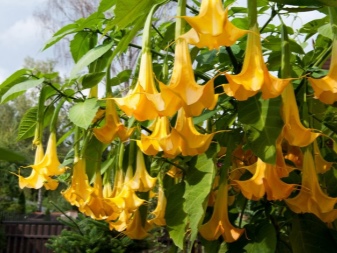
Types and varieties
The genus Brugmansia has several species, which mainly differ in color and type of buds.
Tree-like
In its natural environment, the plant can be found in Chile, Peru, Bolivia and Ecuador. It blooms in white or pink. The bush can grow up to 3 m in height, the tubular-bell-shaped buds are about 20 cm long. Due to its tropical nature, this species is grown as an indoor or greenhouse plant, since it dies at a temperature of -1 degrees. Distinctive features of representatives of the species are considered fibrous roots and lignified stems.
The leaf plates have an elliptical shape with solid edges and are covered with a light fluff.

Snow-white, or trumpet of an angel
This brugmansia is also known as arboreal in our country, in its natural environment it can grow up to 3 meters, but at home the tree reaches a much smaller size. The flowers in representatives of this species are predominantly white, although, depending on the variety, they can acquire a pinkish and light yellow tint. Their shape is elongated, tubular. The leaf plates are oval, slightly pubescent, placed on rather long petioles.The buds on the plant are formed only when the indicators of night and day temperatures become without large differences.
This species mainly exists in hybrid forms.
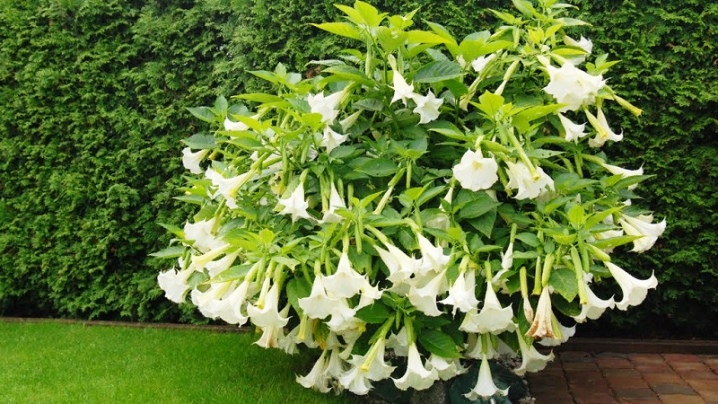
Fragrant or aromatic
This brugmansia appeared in Brazil, therefore a hot climate is preferable for her. Under suitable conditions, the plant can form flower buds all year round (indoors). It grows up to 5 meters, so the ceilings in the room must be high. The buds are also quite large, in some varieties their length reaches 30 cm, they are painted in a white or light green tone. Representatives of this species differ in rather rapid growth.
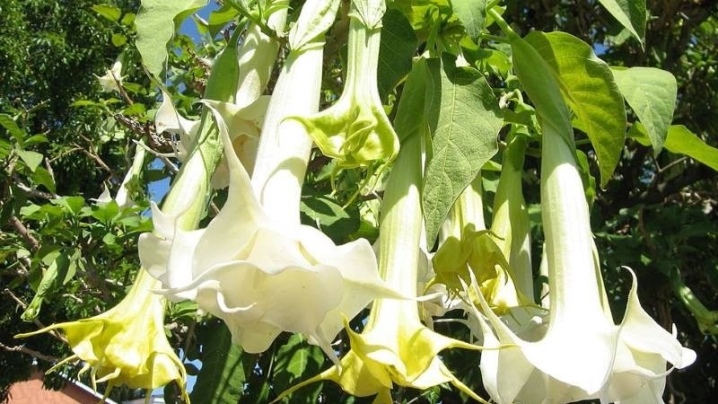
Golden
The flowers of this species have a beautiful rich yellow color. Also, the plants have rather large leaves, in some specimens they reach 50 cm.The north of Colombia is considered the homeland of the shrub.
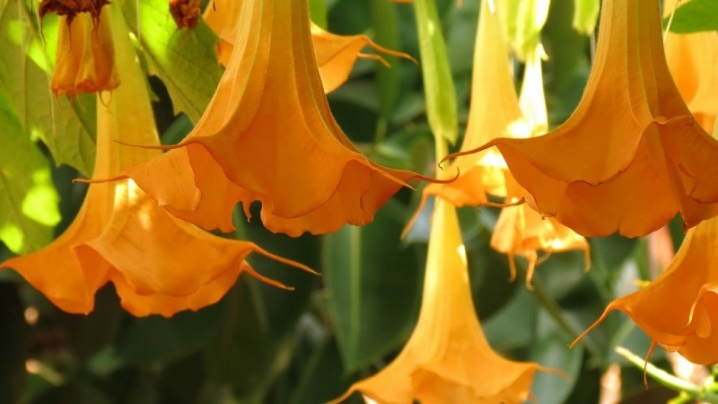
Bloody
The representatives of the species can be recognized by the orange-red color of the petals; they also have pronounced yellow veins and scarlet edging. At prolonged high temperatures (above + 25 °), the plant sheds its buds and does not bloom. The species differs in frost resistance, therefore it is quite possible to cultivate it in a temperate climatic zone. In nature, representatives of this brugmansia can be found in Ecuador and Chile.
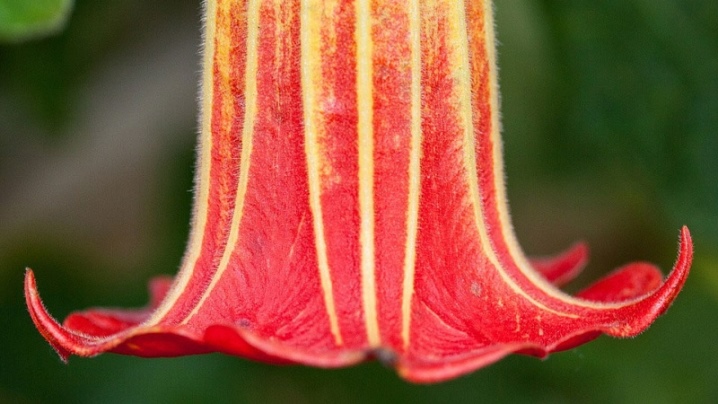
Multicolored
The flowering plant has a very spectacular appearance, which is why it got its name. Only the petals that appear are white, then they turn into a peach or orange hue. The height of the brugmansia is 4 m, and the flowers are 30-50 cm.

Landing
Brugmansia is mainly grown in large containers. It should be planted in open soil in regions with a warm climate, since the plant is very thermophilic and hard to tolerate frost. A shrub grown in a tub needs to be replanted several times a year, because it grows quite quickly, but this must be done carefully - by transshipment. The container should be fairly deep and wide. For good growth of brugmansia, nutrient soil with any acidity is preferable.
Potting soil is often used for palm trees, but you can prepare it yourself from mixed in equal proportions:
- peat;
- humus;
- sand.
You can also take rotted leafy soil, peat, humus, perlite in equal parts, adding sod land to them (2 parts).
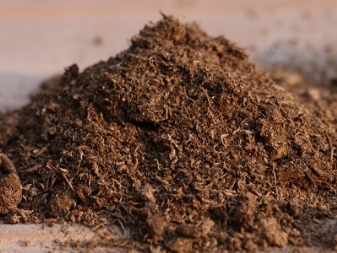
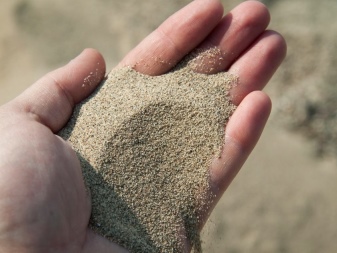
Timing
It is recommended to plant brugmansia in open soil at the end of May, when the threat of night frosts has finally passed. The optimum temperature for shrubs in summer is + 18-28 °, and in winter - + 8-12 °, on this basis, experienced florists recommend cultivating a flower as a tub culture, since in the middle lane it does not overwinter in the open field.

Technology
It is recommended to treat the substrate for planting with a light solution of potassium permanganate. At the bottom of the tub or planting hole, it is necessary to place drainage without fail, as well as compost or manure, then place the plant together with an earthen clod and sprinkle it with soil mixture.
A place for planting or placing a tub with brugmansia is worth choosing well lit, but the light should be diffused. The flower should be protected from drafts. It must be remembered that in the shade, the angelic trumpets will bloom sparsely, but the foliage will be plentiful.

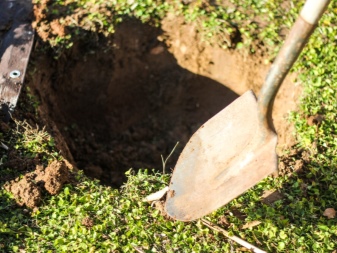
Subtleties of care
When cultivating brugmansy, you need to know that she loves light and warmth. In winter, if it is not possible to provide such conditions, you can leave it in a cool room until spring (the plant will be dormant). "Archangel pipes", which grow in tubs, develop better at a temperature of + 23-25 °, in the summer the room needs to be ventilated or the plant should be taken out into fresh air. For an indoor green pet, the south side with good lighting is more suitable.
In the absence of intense light, it is worth considering additional.
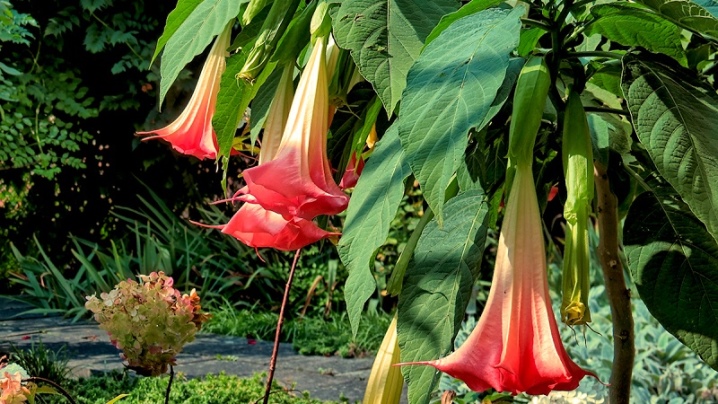
Watering
During the warm period, the plant needs abundant and regular watering, after flowering, it needs to be slightly reduced... Brugmansia reacts well to spraying, while you need to not allow water to get on the buds. During the rest period - in winter - it is recommended to water the flower rarely and with a small amount of water, but not to allow the soil to dry out. If the plant blooms and develops in winter, then moisture should be normal. It is better to take water for irrigation that is settled and not cold.
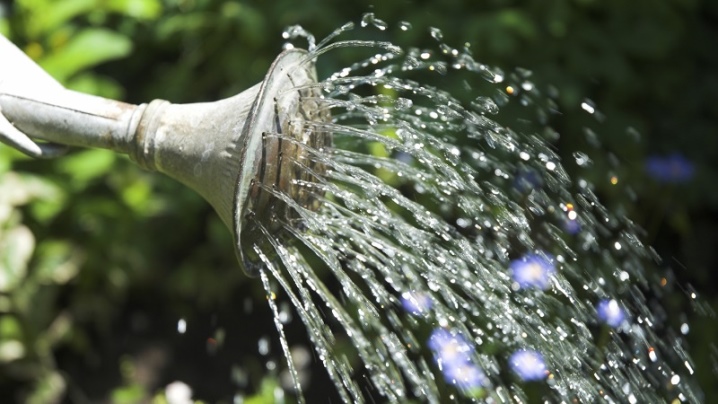
Top dressing
It is worth starting to feed brugmansia in the spring, for this you can take a mullein solution in a ratio of 1: 10 or fertilizer with nitrogen. During the summer, the plant is fertilized with complex mineral and organic fertilizing every 1-2 weeks. During flowering, you need to make compounds with potassium and phosphorus. In the cold period, if the flower is not in a state of rest, it is enough to feed it once a month, otherwise fertilizers are not used.
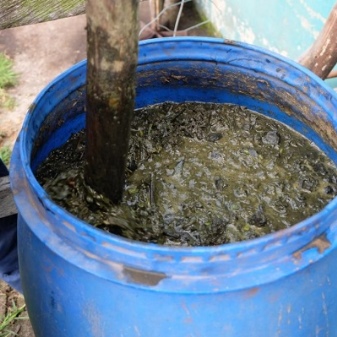
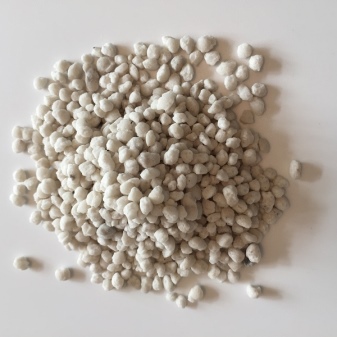
Pruning
Brugmansia is characterized by a rather rapid growth, therefore, it needs a haircut, in addition, in this way, you can shape the crown and give it the desired shape. Experienced growers recommend pruning in early spring. First, old and dry branches are removed, the rest are shortened by a third. For the first time, the plant can be pruned two years after the first flowering.
The side branches should be left as they form the majority of the buds. During the summer, it is also necessary to periodically cut off the appearing stepchildren: they reduce the abundance of flowering.
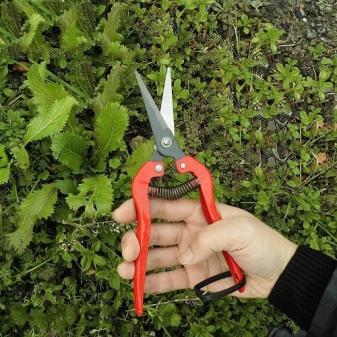
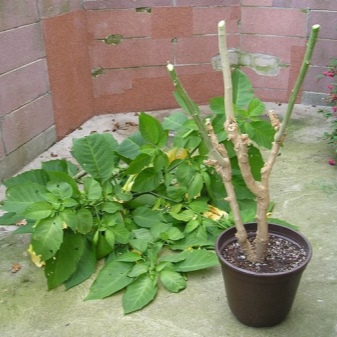
Preparing for winter
For wintering, it is recommended to move brugmansia to a cool room from +13 degrees and below (up to +5), then the plant will be in a dormant period, and its growth stops until spring. The flower is not fed and is rarely watered, but it is recommended to spray and air it regularly. As for lighting, the plant should organize additional lighting (optimally, daylight hours should last about 12 hours). Plants that grow in open soil are dug up for the winter, divided into several parts (optional). Each of them is placed in an individual container and stored in the basement.
It may happen that the top of the plant froze during wintering (the temperature was too low), then in spring it needs to be cut off and rooted in water, and then planted in the usual way. If you want brugmansia to continue to bloom in winter, it should provide certain conditions:
- warm room;
- good lighting.
It must be remembered that in this case the plant is quickly depleted and may die in a few years. Therefore, in order to enjoy the beauty of the "archangel's trumpets" for a longer time, it is better to properly prepare the plant for the period of winter dormancy. As you can see, it is not difficult to care for brugmansia, but at the same time you can get a spectacular flower that will decorate any home or garden.

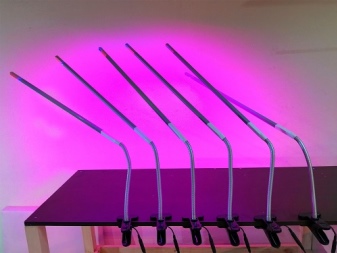
Reproduction methods
The breeding process of brugmansia is not difficult, moreover, this can be done in several ways.
Seeds
A flower grown in this way is capable of blooming for 2-3 years of life. You can propagate a culture by seeds like this:
- due to the rather dense structure, you need to scratch the surface of the seeds a little - this way they sprout faster;
- keep the seeds in a growth stimulator for about 2 days;
- plant in a container with light soil to a depth of about 1 cm, moisten, cover with foil;
- keep the container in a well-lit place for 3 weeks, remembering to ventilate;
- then remove the shelter;
- seedlings need to be sprayed 2-3 times a day with cold water;
- after the appearance of 4–5 leaves, the seedlings dive into separate cups.
Two month old seedlings can be fed nitrogen-containing fertilizers, and after another 2 months - complex. When using this method, it must be remembered that quite often brugmansia does not receive maternal characteristics and can differ in both the size and color of the buds.
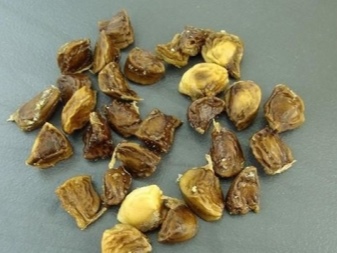

Cuttings
The method of cuttings is used mainly in the spring, then the cuttings take root rather quickly, although it is possible to carry out the procedure in the fall - before the onset of frost. The cuttings must be strong and have at least one fork. They also need to remove the leaves, this procedure will keep the cuttings strong. The cut is treated with a growth stimulant, then placed in a container with water. Every day you need to change the water, after about 10 days, roots are formed, and the seedling can be planted in the soil.
After 4 weeks, the sprout should be transplanted into a larger pot.
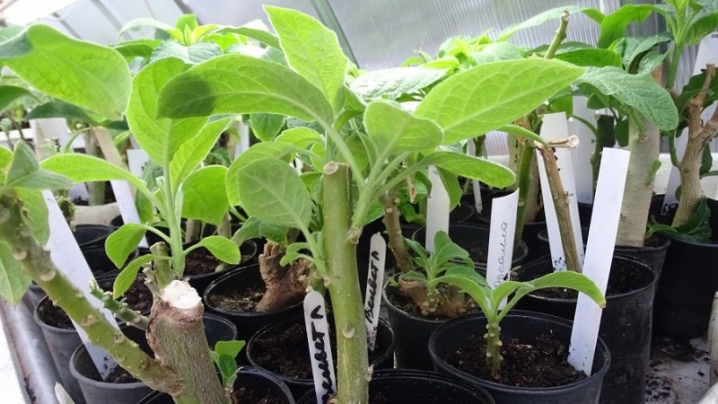
Taps
When propagated by this method, the flower does not differ in special height, but it blooms quite luxuriantly. It is used mainly in late spring - early summer. From the upper part of the plant, the strongest last year's shoots with a diameter of 2 cm are selected. They make cuts in the form of Y for a quarter of the thickness and watered well with a growth stimulator. Then, in place of the cuts, you need to put wet moss and wrap the shoots with a film, securing it with thread.
Throughout the month, the moss must be regularly moistened; this can be done with a syringe. After about 30–40 days, roots begin to form, then the leaves and buds should be removed from the branch, the moss should be removed, and the shoot itself should be cut off and planted in nutrient soil. For rooting to be faster and more successful, it must be sprayed every day and protected from direct sunlight.

Diseases and pests
Although brugmansia is a poisonous plant, it is often affected by various pests. Damaged leaf plates and buds can be seen on the plant, they turn yellow and fall off. Such insecticidal preparations as "Actellik", "Agravertin", "Fiopharm", Plant Spray are effective against parasites. They need to be applied several times a week, the reverse sides of the leaves and internodes must be very carefully processed. Of the pests, Brugmansia is most often annoying:
- weevil - affects leaf plates, gets rid of it mechanically;
- whitefly and aphids - feed on the sap of the plant, depriving it of strength;
- spider mite - manifests itself by the presence of a thin web on the leaves, auxiliary measures in the fight against it - wipe the plates with a damp sponge or treat with tincture of garlic, dandelion and yarrow;
- snails, slugs and caterpillars - may appear on the plant due to high humidity, the fight against them consists in the use of insecticides.
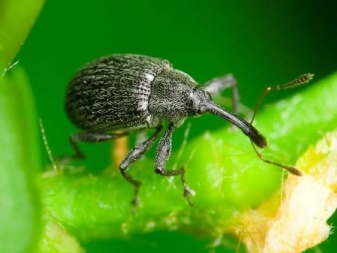
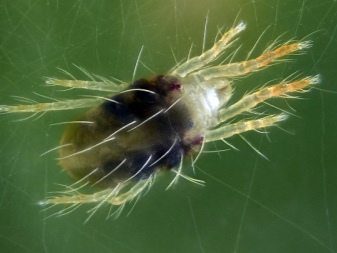
With improper care or conditions of detention, brugmansia can suffer from various diseases.
- Gray rot appears from waterlogging of the soil. Treatment consists in removing all infected parts, thoroughly treating the ground part with fungicidal preparations and adjusting the irrigation regime. For preventive purposes, the peri-stem circle is watered with a solution of lime once a year, dampness and stagnation of water at the roots are avoided.
- Spots and streaks the plant indicates a viral disease. It is better to destroy the affected plants, otherwise they can cause disease in other crops.
Other problems can arise in the cultivation of brugmansy. Too elongated and brittle shoots indicate a lack of lighting. In order for the shrub to return to normal, you need to rearrange it in a place with bright light. The same reason can be manifested by the lack of flowering of brugmansia. If a shrub sheds foliage, it means that it lacks moisture.
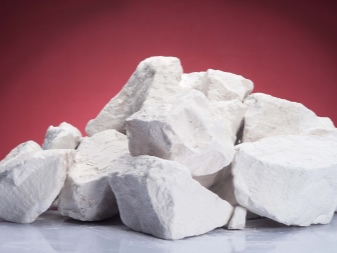

Use in landscape design
A plant with graceful large buds will decorate any site... "Angel pipes" look great in group plantings in the country, in the garden or in a flower bed, but the shrub planted alone is also extremely charming. The plant is used to decorate rooms, terraces, balconies. But with all the beauty during cultivation, it must be remembered that it is poisonous and you need to be very careful if there are children or animals in the house. Besides, because of the rather strong aroma, it is not worth keeping a flower in the bedroom.
Charming brugmansia will become a decoration of your home or garden for a long time, if you devote just a little time to it, looking after and caring for it.
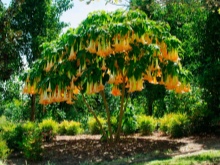
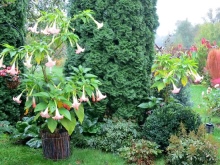
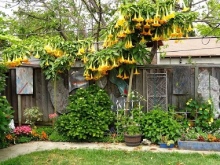
In the next video, you are waiting for the preparation of Brugmansia for wintering.







































































































The comment was sent successfully.